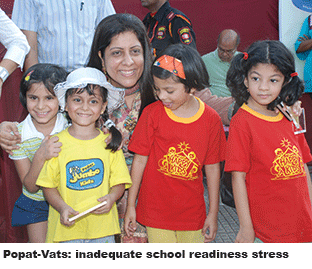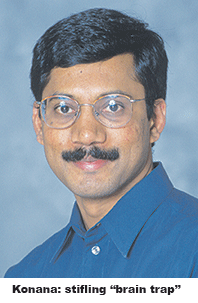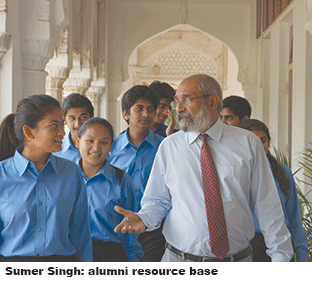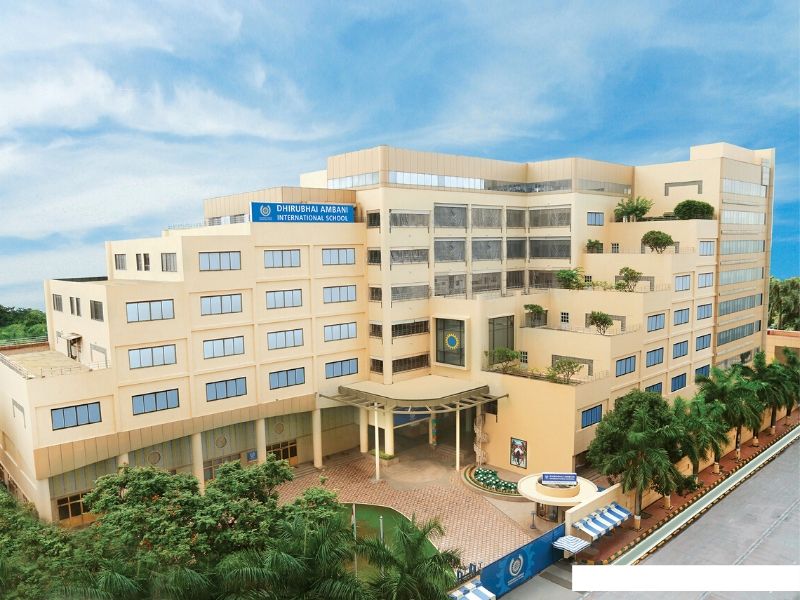Against a depressing backdrop of the country’s education system stewing in a full-blown but unacknowledged crisis, EducationWorld presents solutions which if expeditiously translated into action could accelerate overdue reform of early childhood, primary, secondary and higher education in 21st century India – Dilip Thakore
 To say that a crisis is brewing within Indian education is an understatement. The plain, unvarnished truth is that all four sectors of the country’s education system — early childhood, primary, secondary and higher — are already stewing in a full-blown crisis which neither purblind officialdom, the establishment nor Indian society are willing to acknowledge. For 16 years to date, the editors of EducationWorld — promoted to “build the pressure of public opinion to make education the #1 item on the national agenda” — have been tracking the continuous slide of the education system and warning of the consequences. Regrettably, ours is a lonely voice in the wilderness.
To say that a crisis is brewing within Indian education is an understatement. The plain, unvarnished truth is that all four sectors of the country’s education system — early childhood, primary, secondary and higher — are already stewing in a full-blown crisis which neither purblind officialdom, the establishment nor Indian society are willing to acknowledge. For 16 years to date, the editors of EducationWorld — promoted to “build the pressure of public opinion to make education the #1 item on the national agenda” — have been tracking the continuous slide of the education system and warning of the consequences. Regrettably, ours is a lonely voice in the wilderness.
Curiously, within the sleepy bowers of Indian academia constantly slipping standards of school and higher education are ringing few, if any, alarm bells. In seminar halls across the country, esoteric communities of all-expenses paid academics passively debate education issues. Learned professors come and go, speaking of Michelangelo, but no sooner than workshops and seminars — from which learned keynote speakers promptly exit as soon as their homilies are delivered — are over, it’s back to teaching and drawing inflated salaries and entitlements as usual.
Meanwhile, encumbered with poorly conceputalised syllabuses translated into obsolete curriculums by ill-trained and indifferent teachers, the overwhelming majority of children and youth in the country’s 1.6 million anganwadis, 300,000 private pre-primaries, 1.40 million primary-secondary schools, 47,000 colleges and 800 universities are not only running hard to stay in the same place, but are actually falling behind in the newly-emergent global marketplace for goods, skills and services.
The evidence is not merely persuasive, it’s overwhelming. For over a decade, year after year, the Annual Status of Education Report (ASER) published by Pratham, the highly-reputed Mumbai-based NGO, has been painstakingly documenting declining learning outcomes in rural primary schools in over 500 (of the country’s 640) districts. The latest ASER 2014 published last January, the collective effort of over 20,000 volunteers who conducted field studies testing children in 588 rural districts countrywide, indicates that 53 percent of children in class V cannot read/ comprehend class II textbooks and 74 percent cannot manage simple division sums. Five years ago in 2009, the corresponding statistics were 47 and 72 percent.
“This proportion decreased each year from 2009 to 2012, dropping from 52 percent in 2009 to 46.9 percent in 2012. Among class V children enrolled in government schools, the percentage of children able to read class II level texts decreased from 50.3 percent (2009) to 43.8 percent (2011) to 41.1 (2013),” comment the authors of ASER 2013. Since then after the ill-formulated Right of Children to Free and Compulsory Education (RTE) Act, 2009 has mandated that no child in primary school is obliged to repeat a year in the same class, i.e, must compulsorily be promoted, learning outcomes in rural primaries, as indicated above, have been falling continuously with grave — but unheeded — consequences for national productivity.
Regrettably, despite a small minority of India’s newly-emergent international and legacy boarding schools having attained teaching-learning equivalence with the best in the West, the great majority of the country’s estimated 237,000 secondary schools, lumbered with obsolete and unimaginative syllabuses and ill-trained teachers, are not much to write home about either. In 2009, a cohort of students from government and mid-market private schools in Himachal Pradesh and Tamil Nadu — states which are top-ranked in the Education Development Index (EDI) of the Delhi-based National University of Educational Planning and Administration — wrote the PISA (Programme for International Student Assessment) test of OECD (a club of developed industrial nations including Japan and South Korea) which tests the maths and science learning attainments of 15-year-olds in over 70 countries. Shockingly, the Indian cohort was ranked 73rd among 74 countries, besting only Kyrgyzstan. Since then, India has stopped sending students for PISA tests.
The record in higher education is hardly any better. None of the country’s 47,000 undergrad colleges or 800 universities — three of them (Calcutta, Bombay and Madras) established in 1857 — with an aggregate enrolment of 20 million students were ranked among the global Top 200 in the World University Rankings (WUR) league tables of the globally-reputed London-based Quacquarelli Symonds (QS) and Times Higher Education in 2014. This year two institutions of higher education, viz, the Indian Institute of Science, Bangalore and IIT-Delhi have been ranked #147 and #179 respectively in QS’ Top 200 WUR.
Informed monitors of contemporary India’s chaotic and ramshackle education system are unanimous that it is in deep rot.
Although they are not as publicly vocal about it, privately most agree that the root cause is insufficient provision for public education. “While OECD and several ASEAN countries are investing 7-10 percent of GDP for public education, in India annual allocations of the Centre plus state governments for education have never crossed 4 percent. The basic problem is that the pie to be shared by the country’s public primary, secondary and higher education institutions is much too small to be sufficient,” opines Dr. Krishna Kumar, the highly-respected former director of the National Council of Educational Research and Training (NCERT) and professor of education at Delhi University. An alum of Sagar (Madhya Pradesh) and Toronto (Canada) universities, Krishna Kumar has also authored several insightful books including Social Character of Learning (1989), Learning from Conflict (Orient Longman, 1996), Prejudice and Pride (Viking/Penguin, 2001), What is Worth Teaching (2004), Political Agenda of Education (2006), Battle for Peace (Penguin, 2007) and A Pedagogue’s Romance: Reflections on Schooling (2008), among others.
On whether Indian education is in deep crisis, Krishna Kumar advises “nuanced assessment”. “In primary education, some states such as Tamil Nadu, Uttarakhand and Himachal Pradesh have attained high enrolment and acceptable learning outcomes.
The deep crisis is in secondary and particularly higher education. A measure of the crisis in higher education is that our universities are suffering 40 percent faculty vacancies, and that universities in Madhya Pradesh where I did my undergraduate studies, haven’t increased their faculty strength since 1980. Continuous under-funding of higher education has disabled our universities from making any global impact in research and knowledge creation,” says Krishna Kumar.
But although it’s a tragic irony that education in post-independence India — a landmass which in 500 BC was a global centre of learning and boasted arguably the world’s greatest and most-admired universities (Nalanda and Takshashila) — is in the doldrums, there are ready remedies available for this shameful situation. Foremost among them is public — especially middle class — acceptance of the critical importance of high-quality public primary, secondary and higher education for national development.
Contrary to popular middle class perception, there are less than six degrees of separation between the country’s 800 million poor and uneducated majority and the middle class and intelligentsia. Clean air, water, crime-free cities and non-toxic farm produce will never become a reality for the relatively prosperous middle class unless high-quality primary education is universalised.
Secondly, the middle class and intelligentsia need to accept that the political class — which quite clearly has a vested interest in perpetuating a dysfunctional public education system for the obvious reason that a universally literate and well-educated populace will never elect the low-calibre public representatives who misrule the nation — won’t seriously drive education reforms. Therefore the pressure for intelligent and sustained reform of the public education system has to be exerted by the nation’s middle class and intelligentsia, in a spirit of enlightened self-interest.
Against this depressing backdrop, on its 16th anniversary, EducationWorld presents 10 solutions which if expeditiously translated into action by the Central and state governments, society and institutional managements could accelerate the overdue process of reform and rehabilitation of early childhood, primary, secondary and higher education in 21st century India.
1. Raise & Sustain Public Education Expenditure
 Way back in 1966, a high-powered, 17-strong Indian Education Commission chaired by Dr. D.S. Kothari, chairman of the University Grants Commission, was constituted to “advise the government on the national pattern of education and on the general principles and policies for the development of education at all stages and in all aspects”. After labouring for 21 months, the commission, which included academics from the US, Russia, the UK and Unesco, produced a comprehensive 287-page report. One of its main recommendations to the Union government was to gradually raise the national (Centre plus states) annual expenditure on public education from 2.9 percent of GDP in 1966 to 6 percent by 1985-86. That recommendation has never been fulfilled. For the past 68 years since independence, the annual national education outlay has averaged 3.5 percent. As a result, the country’s population has tripled, 21st century India hosts the world’s largest citizenry of illiterates, and industry and agriculture productivity is in the bottom decile of countries worldwide.
Way back in 1966, a high-powered, 17-strong Indian Education Commission chaired by Dr. D.S. Kothari, chairman of the University Grants Commission, was constituted to “advise the government on the national pattern of education and on the general principles and policies for the development of education at all stages and in all aspects”. After labouring for 21 months, the commission, which included academics from the US, Russia, the UK and Unesco, produced a comprehensive 287-page report. One of its main recommendations to the Union government was to gradually raise the national (Centre plus states) annual expenditure on public education from 2.9 percent of GDP in 1966 to 6 percent by 1985-86. That recommendation has never been fulfilled. For the past 68 years since independence, the annual national education outlay has averaged 3.5 percent. As a result, the country’s population has tripled, 21st century India hosts the world’s largest citizenry of illiterates, and industry and agriculture productivity is in the bottom decile of countries worldwide.
Ever since EducationWorld was promoted 16 years ago, we have consistently urged India’s 300-million-strong middle class, educationists and the intelligentsia to pressure successive Central and state governments to heed the Kothari Commission’s main recommendation and make larger provision for the country’s government primary and secondary schools and languishing institutions of higher education.
Indeed for nine successive years we greeted Union Budgets presented to Parliament with our own alternative EW lib-lab-lav budgets, painstakingly researched by Dr. A.S. Seetharamu, former professor of education at the Institute for Social & Economic Change, Bangalore, which indicated ways and means to equip every government primary school countrywide with libraries, laboratories and lavatories. Earlier this year when the first, full-fledged Union budget of the BJP-led NDA government unprecedentedly allocated a sum lesser than in 2014-15 for education, we once again presented a detailed schema to enable greater investment in children’s education and health (see table). But so deep is the apathy of middle class India, the academy and intelligentsia towards public education that none of these initiatives has stimulated public discussion or debate.
2. End Neglect of Early Childhood Care and Education
Although self-congratulation is immodest, one of EducationWorld’s great achievements of the past 16 years is sustained advocacy of professionally administered early childhood care and education (ECCE) for India’s 158 million children in the 0-5 age group.
Fully persuaded by Western neuroscience research studies which prove that brain development in children is 90 percent complete by age eight, and supportive research studies of Nobel economics laureate Dr. James Heckman who has established that a dollar invested in ECCE provides greater social returns than a dollar invested later in the education continuum, EducationWorld has been rating and ranking the country’s most respected pre-primary schools in six cities from 2007 onward. Moreover, this publication has staged five Global Early Child Education conferences in Mumbai and Bangalore featuring world-renowned ECCE educators and experts.
“School readiness is the fourth ‘R’ of education — the others are Reading, wRiting and aRithmetic — before children transit to primary school. Regrettably this is an ignored priority and millions of unprepared children experience great stress in the first two years of primary school. I’m not at all surprised that the annual ASER reports which measure real learning attainments of rural, especially government primary school children, indicate poor and declining learning outcomes. This is because children in government primaries countrywide have been denied ECCE and have already lost 60 months of nurturing, learning and development when they enter primary school at age six,” says Swati Popat Vats, Mumbai-based president of the Podar Jumbo Kids chain of 220 pre-primaries countrywide and promoter-president of the Early Childhood Association of India (estb. 2010).
This observation is particularly applicable to the huge majority of children from rural and low-income households. The only ECCE that the more fortunate among them receive is in the country’s 1.6 million anganwadis — nutrition centres for infants and lactating mothers — established since 1975 by the Central government countrywide, which also provide a modicum of learning.
However the annual budgetary provision for anganwadis is grossly inadequate (Rs.8,245.77 crore in 2015-16) and the education provided by the solitary caretaker is mostly informal. Moreover, the country’s 1.6 million anganwadis accommodate only 75 million of the 158 million children in the 0-5 age group.
But the good news is that very belatedly in September 2013, during its last months in office at the Centre, the Congress-led UPA II government approved a draft National Early Childhood Care and Education (NECCE) policy which recommended the upgradation of anganwadis into full-fledged pre-primaries. Yet after the BJP-led NDA government assumed office in Delhi in May 2014 — and unprecedentedly slashed its education outlay in the Union Budget 2015-16 — the chances of the draft NECCE being translated into legislation have dimmed considerably.
Meanwhile, undeterred and fully committed to raising awareness of the critical importance of universalised ECCE, your editors are preparing to stage the sixth EW Early Childhood Education Global Conference 2016 in Bengaluru (aka Bangalore) on January 23. We solicit the support of all educators and right-thinking people in the national interest.
3. Rapidly Multiply the Number of Secondary Schools
 One of the most pressing but least debated problems of Indian education is the nationwide shortage of secondary schools. Although the mad and intensifying annual scramble for admission into the country’s Top 1,000 private schools every summer is ample testimony to a severe shortage of secondary schools, it’s rare to hear any political party, voluntary organisation or citizens group openly calling for transparent rules and regulations for promotion of new, greenfield private schools favoured by citizens across the income strata, including bottom-of-pyramid households. Currently, millions of children are studying in fees-levying informal and often unrecognised budget private schools (BPS) countrywide. According to the Delhi-based Centre for Civil Society, one of the country’s most respected think tanks, the number of BPS countrywide has multiplied to 400,000 with an aggregate enrolment of over 60 million children!
One of the most pressing but least debated problems of Indian education is the nationwide shortage of secondary schools. Although the mad and intensifying annual scramble for admission into the country’s Top 1,000 private schools every summer is ample testimony to a severe shortage of secondary schools, it’s rare to hear any political party, voluntary organisation or citizens group openly calling for transparent rules and regulations for promotion of new, greenfield private schools favoured by citizens across the income strata, including bottom-of-pyramid households. Currently, millions of children are studying in fees-levying informal and often unrecognised budget private schools (BPS) countrywide. According to the Delhi-based Centre for Civil Society, one of the country’s most respected think tanks, the number of BPS countrywide has multiplied to 400,000 with an aggregate enrolment of over 60 million children!
Yet perhaps the greatest impediment of trusts, societies, philanthropists and edupreneurs ready and willing to promote primary-secondary schools is the sky-high price of real estate — out of all proportion to the purchasing power of the populace — in professedly socialist India. Under the traditional school model, huge investment is required in large buildings, sprawling grounds, corridors, majestic assembly halls, libraries and spacious administrative offices. However cost-cutting digital technologies and invention of the BPO (business process outsourcing) model have made it possible to turn this institutional model on its head.
“An edupreneur could rent a small cluster of three-bedroom apartments, convert bedrooms into classrooms with a capacity of about 20-25 students for a total strength of 75 students per apartment, with kitchens serving as functional cafeterias.
Co-curricular education — music, dance, life skills etc — can be outsourced to specialist schools and academies and sports education to neighbourhood gyms and clubs. Classroom lessons and high quality instruction could be provided online by local and foreign tutors for at least six hours per day with only one teacher per class to be employed full-time to maintain discipline and aid and advise students. For writing exams, students could follow the NIOS curriculum or even the CISCE, IGCSE curriculums through contractual agreements with one or more schools to allow students to write exams as independent candidates, or perhaps even as students of the contracted schools, which is perfectly legitimate. This new technologies-driven model which would enable rapid multiplication of secondary schools by sharply reducing real estate capex, is worth exploring,” says Shivram Venkatasubramaniam, an alumnus of BITS-Pilani, IIM-Calcutta and Massachussetts Institute of Technology, and currently the founder-CEO of Looking Glass Ventures Inc, a Palo Alto (USA)-based education technology company.
4. Scale teacher training and development
Knowledgeable monitors of contemporary India are unanimous that one of the great — if not greatest — infirmities of the  country’s K-12 education system is the poor quality of teacher training and preparation dispensed by the nation’s 8,428 teacher training colleges and institutes. According to a recent NUEPA report, 70-80 percent of primary school teachers in state government primaries are higher secondary school-leavers with hastily issued diplomas in teacher training. Informed opinion is also unanimous that the syllabus of the B.Ed postgraduate degree which is mandatory for teachers in government and CBSE-affiliated secondary schools is obsolete and easily available through undemanding correspondence courses.
country’s K-12 education system is the poor quality of teacher training and preparation dispensed by the nation’s 8,428 teacher training colleges and institutes. According to a recent NUEPA report, 70-80 percent of primary school teachers in state government primaries are higher secondary school-leavers with hastily issued diplomas in teacher training. Informed opinion is also unanimous that the syllabus of the B.Ed postgraduate degree which is mandatory for teachers in government and CBSE-affiliated secondary schools is obsolete and easily available through undemanding correspondence courses.
Although progressive schools and education groups such as Indus International, Bangalore, Heritage School, Gurgaon and the Delhi-based Amity Group have latterly begun to offer high quality, internationally benchmarked teacher education, their models are far from scalable. Against this backdrop, the entry into India of the Singapore-based Asian International College (AIC) assumes considerable significance. A wholly-owned subsidiary of Busy Bees Group Ltd — the largest private pre-primary schools chain in the UK — AIC has recently registered an Indian subsidiary, Asian International College-India (AIC-I).
“AIC-I intends to harness the power of new digital technologies to improve teacher development and extend access in India, starting at ground level with preschool teachers. We will deliver flexible, innovative and, most importantly, affordable teacher development programmes. Delivery is largely online, with some optional face-to-face interaction, and course design will ensure learners take centre stage. The AIC model is also highly scalable at low cost. Our intent is not to issue certificates for wall mounting, but to deliver real learning which can be applied in classrooms countrywide to make a real difference to student learning outcomes,” says Dr. Jeremy Williams, an alumnus of Leeds and Hull universities, adjunct professor at Griffith University, Australia, and currently the Mumbai-based academic director of Busy Bees Asia Pte. Ltd.
5. Universalise Vocational Education and Training
 An inexcusable blindspot of post-independence central planners and educationists was — and remains — vocational education and training (VET) for students of all ages. Although over seven decades ago Mahatma Gandhi advocated learning with head, heart and hands, perhaps because of the brahminical mindset of the education ministries and educators community, VET — which is an integral part of the syllabus and curriculums of schools and colleges in OECD (a club of industrially developed countries) — has never been seriously incorporated into education curriculums in India.
An inexcusable blindspot of post-independence central planners and educationists was — and remains — vocational education and training (VET) for students of all ages. Although over seven decades ago Mahatma Gandhi advocated learning with head, heart and hands, perhaps because of the brahminical mindset of the education ministries and educators community, VET — which is an integral part of the syllabus and curriculums of schools and colleges in OECD (a club of industrially developed countries) — has never been seriously incorporated into education curriculums in India.
Even in the country’s 4,298 engineering colleges, minimal importance is accorded to practical as opposed to theoretical, learning. After 68 years of central planning, contemporary India is served by a mere 11,800 VET colleges, including 2,284 Industrial Training Institutes (ITIs) promoted by the Central government. Against this, the neighbouring People’s Republic of China boasts 500,000 VET institutions. With barely 4 percent of the country’s 450 million workforce having received formal VET, it’s hardly surprising that India’s industrial, agriculture and services productivity is among the lowest worldwide.
After decades of prodding, in 2009 the Congress-led UPA-II government promoted a National Skill Development Corporation (NSDC) under the public-private partnership model to fund private providers of VET. But during the past five years, NSDC hasn’t skilled anywhere near the 150 million youth by 2020 it had targeted, and is currently mired in a scandal (see India Today, October 26).
“To recover lost ground and the growth momentum of the Indian economy, VET must be seriously and committedly introduced into the curriculum of all primary-secondary schools with immediate effect. For a start, ESD or enterprise skills development subjects such as how glass, furniture, clothing, houses, processed foods etc, are made, must be taught from class I in all government and private schools. Subsequently, pre-vocational instruction to acquaint students with the basics of manufacturing, modern agriculture and service industries should start from class VIII after which class VIII-XII students should be divided into two streams with 80 percent enroled in VET and skills training, and the remainder into academic education. And in college and universities the entire gamut of soft skills must be taught to students. In particular VET for agriculture has been severely neglected. In this connection, it’s important to note that over 350,000 VET centres have been established in rural China against hardly any in India. Neglect of VET has severely damaged the Indian economy and this damage needs to be urgently repaired,” says Krishan Khanna, an alum of IIT-Kharagpur and promoter of two BSE-listed companies, who forsook a promising career in corporate India to promote i-Watch, a not-for-profit think tank which has been championing VET since it was established in 1992.
6. Encourage India Inc Involvement with Education
Over-hyped leaders of India Inc, despite incurring perhaps the highest employee training costs worldwide, seem supremely unaware that national productivity would improve greatly if the great mismatch between industry requirements and academic inputs was addressed in school and college education. In a growing number of developed countries including Singapore, Holland, the UK and USA, industry bodies are closely involved with the process of planning and formulating school and college/university syllabuses to minimise industry-academia incompatibility.
Curiously despite member companies suffering high employee training and induction costs and minimal productivity per employee, representative organisations of Indian industry don’t experience any such compulsion. On the contrary, when this historic publication was launched with the mission to “build the pressure of public opinion to make education the #1 item on the national agenda”, most leaders of industry refused to lend a helping hand by way of advertising or any other support. Indeed Tarun Das, then the powerful secretary-general of the Confederation of Indian Industry (CII) until he was ousted from office in a corruption scandal, declined to cooperate and share data with EducationWorld despite numerous requests. Spurned by India Inc, this publication owes its survival to the advertising support of medium and small enterprises connected with education for whom we have created national — and even international — markets
However according to Shalini S. Sharma, a former journalist with Financial Express (1989-2005), Businessworld and India Today and currently head of the higher education cell of CII, in recent years the confederation has been making strenuous efforts to become involved with syllabus formulation in higher education. “Although every private university has strong linkages with industry, the engagement of industry with Central and state government colleges and universities is admittedly inadequate. Nevertheless during the past two-three years we have been making daily requests to the University Grants Commission and the Central and state governments to include industry representatives in their academic councils, and we are getting positive response. We are well aware that Indian industry has had to suffer the consequences of dated syllabuses and poor learning outcomes in Indian education and we are ready, willing and able to become involved with academia,” says Sharma.
7. Experiment with Charter Model for Government Schools
 Although for numerous self-serving reasons disguised as ideological and public interest commitment, the great majority of the country’s academics prefer to continue flogging the dead horse of government-provided school education, a conclusive lesson of the past 68 years is that government — especially state governments — cannot manage education institutions with even minimal efficiency. The millions of children dropping out of dysfunctional government schools annually are snowballing into armies of resentful and unemployable youth in all 29 states and seven Union territories, and creating law and order problems.
Although for numerous self-serving reasons disguised as ideological and public interest commitment, the great majority of the country’s academics prefer to continue flogging the dead horse of government-provided school education, a conclusive lesson of the past 68 years is that government — especially state governments — cannot manage education institutions with even minimal efficiency. The millions of children dropping out of dysfunctional government schools annually are snowballing into armies of resentful and unemployable youth in all 29 states and seven Union territories, and creating law and order problems.
Though government exit from primary education is unlikely to be acceptable to public opinion, the charter schools model under which local governments ‘charter’ NGOs and private education providers to manage government schools, allocating them negotiated per student expenditure, which is becoming increasingly popular in the US, is likely to work in India. For one, there’s no shortage of education NGOs and philanthropic educationists with good track records, who are ready to assume this responsibility subject to liberal government supervision.
But over the past seven decades, politicians and bureaucrats neck-deep in teacher appointments and transfer, textbooks publishing and printing rackets as well as well-remunerated but unaccountable government school teachers, have acquired a strong vested interest in the status quo, the poor learning outcomes of hapless students be damned.
Moreover with the country’s 300 million influential middle class having enrolled its children in private schools and totally indifferent to public schools, there’s little pressure for reform of the country’s 1.20 million government primary-secondaries. Meanwhile to assuage public indignation about the pathetic condition of government schools, state governments keep proposing one-sided public-private partnerships (PPPs) designed to fail.
The latest PPP proposal has emanated from the scandals-hit BJP government of Rajasthan. “The PPP model suggested by the state government is unworkable because it’s completely one-sided. The role of the private partner in government schools is limited to contributing the funding, while management of PPP schools has to be entirely as per detailed conditions laid down by the education ministry. There’s nothing in the proposed PPP for eduprenuers, and even philanthropists are likely to be put off by the conditional charity demanded by the government. Instead, the government should devise a genuine charter schools system or opt for the school voucher scheme proposed by the Centre for Civil Society, Delhi under which government issues study vouchers to students which can be encashed by private schools of students’ choice,” says Damodar Goyal, the Jaipur-based promoter-president of the Society for Unaided Schools of Rajasthan.
8. Stimulate democratisation of classrooms.
Though politically, India is a noisy democracy, its classrooms tend to be dictatorships in which the teacher expects exaggerated respect as the sage on stage, rather than function as a guide by the side of students. Questioning is discouraged, dissent is usually punished and peer-to-peer learning, aka the Madras method which was India’s gift to British education, is often viewed as cheating.
respect as the sage on stage, rather than function as a guide by the side of students. Questioning is discouraged, dissent is usually punished and peer-to-peer learning, aka the Madras method which was India’s gift to British education, is often viewed as cheating.
According to Dr. Prabhudev Konana, distinguished teaching professor of the University of Texas at Austin, children and students in India are stifled by a ubiquitous “brain trap” which he describes is “a result of the archaic educational, social, and economic systems that stifle most young minds from blossoming into creative thinkers and highly productive citizens”. In an insightful op-ed page essay in The Hindu (October 16), Konana writes: “Obedience is valued more than the child’s inquisitiveness. We assume disagreeing is disrespectful and obedience is a greater trait than inquisitiveness. Deeply held beliefs are blindly transferred to children. This obedience gets amplified in schools. Many teachers practice stifling discipline and expect obedience, and discourage creative thinking.”
Quite clearly the classroom culture of Indian education is out of step with the temper of the times. A familiar refrain of industry leaders and objective monitors of Indian education is that independent India hasn’t produced a single killer invention or product for over a century. For this egregious failure the ‘obedience’ culture prevalent in the country’s schools (and colleges) is substantially to blame.
9. Permit Foreign Universities in India
 Within the inorganic socialist development model imposed upon the Indian economy for over four decades, “self-sufficiency” was a key watchword of economic policy. Although behind the protection of high tariff walls, the Indian economy became substantially self-sufficient, it also became hopelessly uncompetitive and technologically backward. More unfortunately even the Indian academy was cut off and isolated from the vast pool of knowledge explosion and research-driven technology leaps made in the West. To the extent that even after the substantial liberalisation and deregulation of the economy in 1991, India’s 47,000 undergraduate colleges and 800 universities have become islands of academic mediocrity, dispensing worthless and untrustworthy degrees and certificates. For over a decade, not a single Indian varsity has been ranked among the Top 200 World University Ranking league tables published annually by the respected London-based rating and ranking agencies QS and THE.
Within the inorganic socialist development model imposed upon the Indian economy for over four decades, “self-sufficiency” was a key watchword of economic policy. Although behind the protection of high tariff walls, the Indian economy became substantially self-sufficient, it also became hopelessly uncompetitive and technologically backward. More unfortunately even the Indian academy was cut off and isolated from the vast pool of knowledge explosion and research-driven technology leaps made in the West. To the extent that even after the substantial liberalisation and deregulation of the economy in 1991, India’s 47,000 undergraduate colleges and 800 universities have become islands of academic mediocrity, dispensing worthless and untrustworthy degrees and certificates. For over a decade, not a single Indian varsity has been ranked among the Top 200 World University Ranking league tables published annually by the respected London-based rating and ranking agencies QS and THE.
Despite several ASEAN countries and China allowing British and American universities to establish campuses on their soil, over 300,000 students fleeing abroad annually for higher education, and EducationWorld having written over half a dozen cover stories and features advocating entry of foreign universities into India, the Congress-led UPA I and II governments failed to enact enabling legislation to this effect.
Although a Foreign Educational Institutions (Regulation of Entry and Operations) Bill, 2010, drafted by then Union HRD minister and legal eagle Kapil Sibal, was approved by the Union cabinet on March 15, 2010, it was rejected by the standing committee of Parliament for being hastily and improperly drafted. Since then it has virtually disappeared from the radar of the BJP-led NDA government which is busy packing higher education institutions with party loyalists enamoured with the mythological glories of ancient India.
“The (Modi) government would do well to pull out some of the Bills pending in Parliament such as the final shape of regulatory bodies and the policy on operation of foreign universities in India. Talk of internationalisation sounds hollow without a positive policy on foreign universities. Many universities are said to be waiting in the wings to enter India. Unless a policy is laid down immediately on foreign universities, internationalisation will pass us by,” says T.P. Sreenivasan, executive chairman of the Kerala State Higher Education Council writing in The Hindu (October 20). This is good and timely advice but unlikely to be heeded by the Modi government without public pressure.Within the inorganic socialist development model imposed upon the Indian economy for over four decades, “self-sufficiency” was a key watchword of economic policy. Although behind the protection of high tariff walls, the Indian economy became substantially self-sufficient, it also became hopelessly uncompetitive and technologically backward. More unfortunately even the Indian academy was cut off and isolated from the vast pool of knowledge explosion and research-driven technology leaps made in the West. To the extent that even after the substantial liberalisation and deregulation of the economy in 1991, India’s 47,000 undergraduate colleges and 800 universities have become islands of academic mediocrity, dispensing worthless and untrustworthy degrees and certificates. For over a decade, not a single Indian varsity has been ranked among the Top 200 World University Ranking league tables published annually by the respected London-based rating and ranking agencies QS and THE.
Despite several ASEAN countries and China allowing British and American universities to establish campuses on their soil, over 300,000 students fleeing abroad annually for higher education, and EducationWorld having written over half a dozen cover stories and features advocating entry of foreign universities into India, the Congress-led UPA I and II governments failed to enact enabling legislation to this effect.
Although a Foreign Educational Institutions (Regulation of Entry and Operations) Bill, 2010, drafted by then Union HRD minister and legal eagle Kapil Sibal, was approved by the Union cabinet on March 15, 2010, it was rejected by the standing committee of Parliament for being hastily and improperly drafted. Since then it has virtually disappeared from the radar of the BJP-led NDA government which is busy packing higher education institutions with party loyalists enamoured with the mythological glories of ancient India.
“The (Modi) government would do well to pull out some of the Bills pending in Parliament such as the final shape of regulatory bodies and the policy on operation of foreign universities in India. Talk of internationalisation sounds hollow without a positive policy on foreign universities. Many universities are said to be waiting in the wings to enter India. Unless a policy is laid down immediately on foreign universities, internationalisation will pass us by,” says T.P. Sreenivasan, executive chairman of the Kerala State Higher Education Council writing in The Hindu (October 20). This is good and timely advice but unlikely to be heeded by the Modi government without public pressure.
10.Encourage Fund-raising in Academic Institutions
 It’s well known that the great American universities which dominate the World University Rankings league tables published annually by the London-based QS and Times Higher Education are also the richest education institutions worldwide. Harvard University’s current endowment corpus is $36 billion (Rs.233,731 crore) and Yale’s $23.9 billion. But, India’s purblind academics who invariably offer the excuse of inadequate funds for failure to conduct research and introduce teaching-learning innovations, haven’t learned any lessons from the success of America’s great universities.
It’s well known that the great American universities which dominate the World University Rankings league tables published annually by the London-based QS and Times Higher Education are also the richest education institutions worldwide. Harvard University’s current endowment corpus is $36 billion (Rs.233,731 crore) and Yale’s $23.9 billion. But, India’s purblind academics who invariably offer the excuse of inadequate funds for failure to conduct research and introduce teaching-learning innovations, haven’t learned any lessons from the success of America’s great universities.
In the US every education institution systematically solicits and raises large and small sums from its alumni — liberally awarding naming rights — to build infrastructure and accumulate endowment corpuses. India with its huge 300 million-strong educated middle class offers a similar opportunity. It’s highly improbable that the millions of graduates of the country’s 1.40 million schools, 47,000 colleges and 800 universities, who have received heavily subsidised education, will be reluctant to donate small sums of Rs.1,000-5,000 annually, if donations are professionally solicited from their alma mater for institution building. Unfortunately most of the country’s inertia-infused principals and academics have neglected to adequately utilise their alumni resource for fund raising.
However there are exceptions to the rule. Venture capitalist Ashish Dhawan, Sanjeev Bhikchandani, promoter CEO of naukri.com together with several other philanthropists have raised over $500 million (Rs.3,246 crore) by way of ‘crowd-funding’ (donations of $1-10 million plus) from hundreds of donors in India and abroad to construct and endow the private state-of-the-art Ashoka University which admitted its first batch of 133 liberal arts students in 2014 (see EW cover feature January 2015). Even the Central government-promoted IIT-Bombay and IIM-Ahmedabad have accumulated sizeable Rs.100 crore-plus endowment corpuses by tapping into their alumni databases.
Nor is organised fund-raising restricted to higher education institutions. The superb Dhirubhai Ambani Auditorium of the Daly College, Indore has been funded by a Rs.1 crore donation from Reliance Industries chairman Mukesh Ambani with the additional Rs.3.5 crore donated by over 100 alumni, with each seat within bearing the nameplate of the donor. “We regard our alumni as a valuable resource base and keep in touch with the numerous country and city chapters we encourage them to establish. Right now we are raising funds for a Rs.20 crore private Daly College University for which we have already received pledges for Rs.13 crore,” says Sumer Singh, principal of Daly College.
In The Doon School, Dehradun (estb. 1935), a full-time director of development and alumni relations manages the school’s endowment corpus (Rs.45 crore), annual fund (for alums who routinely contribute less than Rs.50K yearly), major donors, asset replacement (project specific) and restricted (scholarships) funds. “We value our alumni and well-wishers very highly, and professionally maintain a thoroughly updated database of alumni who are kept informed of all our development plans,” says Peter Mclaughlin, headmaster of The Doon School ranked the country’s #1 boys boarding school in the latest EducationWorld India School Rankings 2015.
Conclusion. Although the great majority of India’s professors and pundits are unwarrantedly complacent, it’s incontrovertible that India’s sclerotic education system from K-Ph D is in a state of crisis, when the usual response of glossing over the problem is likely to prove disastrous. Right now Indian society, which grudgingly hosts the world’s largest child and youth population (550 million), is confronted with the humongous problem of generating 12 million jobs per year and educating youth to fit into these jobs.
The 10 quick-fix ideas set out above offer policy formulators, schools, colleges and universities solutions to begin the education reforms process. But this process is unlikely to begin without pressure from the academy, intelligentsia and the middle class. Ignore this grave issue at your peril.


















